Abstract
Over the last fifty years, Critical Race Theory (CRT) has become pivotal to legal, political, and educational theory and practice. What are its implications for the field of historic preservation (and why aren’t preservationists asking this question)? This essay examines preservation practice through the lens of CRT, articulating a series of questions and provocations that require attention as the field attempts to repair its history of Black, Indigenous, and POC erasure.
Part of what has made the preservation movement so perniciously effective at encoding racial hierarchies and norms into our public landscape is its appearance of innocuousness. Through federal and state laws and regulations that date to the 1960s, preservation policies serve as a constraint on the demolition of historic structures and neighborhoods. In cities and towns across the country, preservation nonprofits rely on philanthropy to fund their advocacy campaigns, which invariably argue for a direct line between the preservation of historic buildings and monuments and civic vitality. At the institutional or individual level, preservation stories are presented as community-minded efforts to commemorate local history or to build sustainably (“the greenest building is one that’s already built,” etc.). Preservationists talk a lot about “community revitalization,” and who could be against that?
The truth is that preservation is also, and maybe essentially, an economic, political, legal, cultural, and racial system that has provided goods and value for white interests (). Preservation is no different from our legal, financial, and educational systems in this way, which present as colorblind but are fundamentally and systemically racist. The Critical Race Theory (CRT) movement, which grew out of the legal scholarship of Derrick Bell and other scholars of color in the 1980s and 1990s, exploded accepted truths about the so-called racial objectivity of the law, unmasking the legal system’s perpetuation of racism and inequality ().Footnote1 The insights of CRT theory have since been applied to other fields. A 1995 article by the Black education scholars Gloria Ladson-Billings and William Tate argued that race had been undertheorized in scholarship on education, leading to the misapprehension of the racial basis of educational inequalityFootnote2. In the design fields, this approach is beginning to emerge in Critical Race Design and Design Justice, which acknowledge the complicity of architecture and design in extending racial hierarchies and inequality, and attempt to map new practices that are resistant and liberatoryFootnote3.
Figure 1. Action organized by Action Group for Better Architecture in New York to protest the demolition of the old Penn Station, August 2, 1962. Photograph: Eddie Hausner/The New York Times/Redux.

Figure 2. Harvard Law School professor Derrick Bell (center) walking with a group of law students on campus after taking a voluntary unpaid leave of absence to protest the law school’s practice of not granting tenure to minority women professors. Photo by Steve Liss/Getty Images.
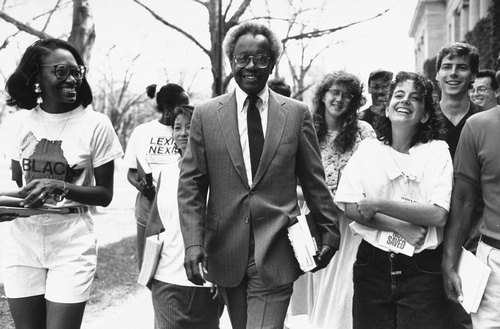
And in the field of preservation? While there are initiatives underway to diversify the buildings and sites that receive preservation dollars and attention, and to add resources related to participatory planning and social equity to course syllabi and university curricula, the extent to which racism is embedded in the history, theories, tools, and practices of preservation is still, as it was in the field of education twenty-five years ago, woefully undertheorized.Footnote4 Ladson-Billings and Tate argued, almost thirty years ago now, that the “multicultural paradigm (in education) is mired in liberal ideology that offers no radical change in the current order.”Footnote5 The same might be said for the field of preservation today, which is attempting a similarly additive strategy without adequately interrogating the racial dimensions that may lie at the heart of its practice.
If we accept the fact that race is a construct, we must ask how heritage and preserved sites participate in its construction. If we accept the fact that our legal, political, economic, and cultural systems perpetuate racism, we must ask how preservation, public art, and spatial practice do this work. If, following the work of CRT scholars, we accept the fact that seemingly neutral concepts like “history” and “heritage” advance the interests of dominant groups—in this case, white interests—then we must ask how preservation, which is linked so closely to these fields, advances white interests. What are the inherent biases in preservation policy and practice? How does preservation encode cultural norms and hierarchies, and how does it enshrine what’s normative in public space? How does preservation participate in BIPOC erasure—and how does this erasure relate to disenfranchisement?
Preservation, after all, is one of many ways in which space is claimed and marked by certain groups whose histories are assigned greater value than others. There is a finite amount of public space available after all, so preservation is a zero-sum game. In Urban Planning and the African-American Community, the Black planning historian June Manning Thomas and Marsha Ritzdorf write that modern zoning laws and racially restrictive covenants “protected socioeconomic segregation and limited the mobility of people of color.”Footnote6 While it didn’t legally encode racial geographies into space as these tools did, there is no doubt that preservation and gentrification have advanced white interests incrementally via individual actions and transactions that are harder to trace, for the multiplicity of sites and actors involved.
A reckoning with this history is necessary. It is not enough to acknowledge that preservation has been inequitable, and to initiate actions that merely diversify preservation offices and sites today. This, unfortunately, seems to be the current trajectory of the field, where the dominant mode of discourse is celebratory, and inclusivity is preferred over reparative practice. This may work when a site is uncontested, or when it signifies a narrative that is commonly accepted and does not challenge the authority of white interests too deeply. But what happens when a historic site is contested?
CRT scholars have long understood the powerful impacts of storytelling on our legal system. In 1989, Richard Delgado, one of the key scholars of the CRT movement, wrote, “The stories or narratives told by the ingroup remind it of its identity in relation to outgroups, and provide it with a form of shared reality in which its own superior position is seen as natural.”Footnote7 Preservation, of course, is a powerful form of storytelling, synthesizing public history and spatial practice to produce identity and to materialize power relations. In CRT legal and educational practice, counter-storytelling (sometimes called “voice scholarship”) subverts master narratives, making space for testimonials and viewpoints that were—and still are—left out of the kinds of documents and studies that shape the field.Footnote8 Counter-stories enable marginalized groups to “form a new collectivity based on the shared story,” and provide critical insights into racial and other forms of bias that are endemic to seemingly neutral systems like the law and education.Footnote9
But federal preservation laws and procedures are not set up to accommodate counter-stories or to integrate what Delgado calls “outgroup” claims or testimonials about historic sites. Take the case of the murals that are currently installed in the headquarters of the Environmental Protection Agency (EPA) in Washington, DC at the William Jefferson Clinton Federal Building, a massive Classical Revival building that stretches an entire block between Pennsylvania and Constitution Avenues (). The murals were commissioned as part of the Works Progress Administration initiative in the 1930s, and there were more than twenty of them in all (they are also called the Ariel Rios murals as that was the name of the building until 2013). When they were installed, the building served as the headquarters for the U.S. Post Office, but when EPA staff moved in, the murals became controversial and problematic for many of the Native staff as many of them depicted violent scenes of physical and sexual assault, scalping, and the massacre of colonial settlers and mail carriers by Native peoples.Footnote10 These paintings included Covered Wagon Attacked by Indians (1937) by William C. Palmer (), and two murals by the white Colorado artist Frank Mechau: Pony Express () and Dangers of the Mail ().
Figure 3. William Jefferson Clinton Federal Building, June 22, 2014. Photographer: Ken Lund via Flickr, https://www.flickr.com/photos/kenlund/14484399542.
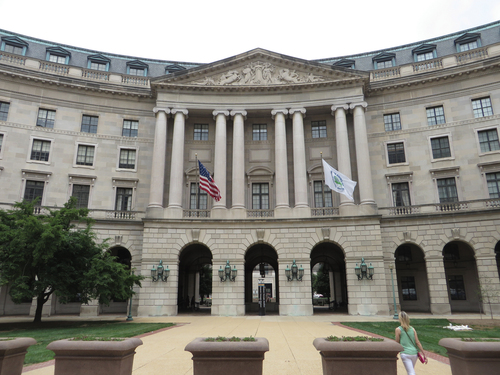
Figure 4. William C. Palmer, Covered Wagon Attacked by Indians (1937), 84 x 162 inches. Commissioned through the Section of Fine Arts, 1934–43. Photographs in the Carol M. Highsmith Archive, Library of Congress, Prints and Photographs Division. Gift, Carol M. Highsmith, 2009 (DLC/PP-2009:083).
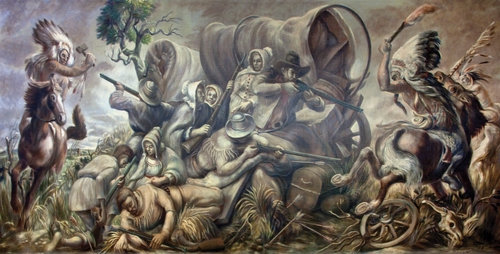
Figure 5. Frank Mechau, Pony Express (1937), 60 x 138 inches. Commissioned through the Section of Fine Arts, 1934–43. Photographs in the Carol M. Highsmith Archive, Library of Congress, Prints and Photographs Division. Gift, Carol M. Highsmith, 2009 (DLC/PP-2009:083).
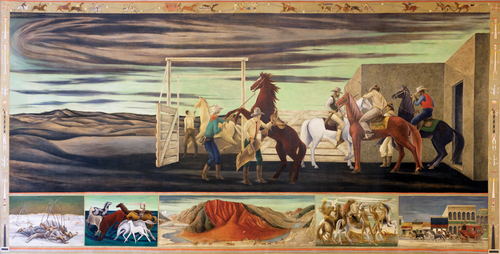
Figure 6. Frank Mechau, Dangers of the Mail (1937), 84 x 156 inches. Commissioned through the Section of Fine Arts, 1934–43. Photographs in the Carol M. Highsmith Archive, Library of Congress, Prints and Photographs Division. Gift, Carol M. Highsmith, 2009 (DLC/PP-2009:083).
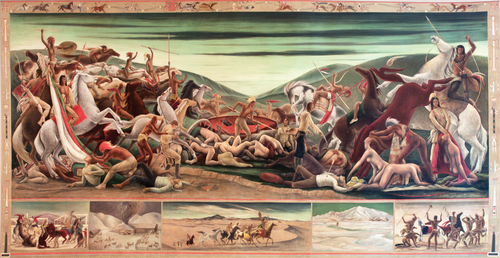
The most explicit mural, Dangers of the Mail, is thirteen feet wide and seven feet high. It imagines a scene of violent carnage in which twelve Native warriors encircle and savagely attack a group of white settlers. The scene includes one male settler being knifed in the back and another being scalped while others lie motionless on the ground with arrows sticking out of their chests and backs. Six white women are depicted naked, many of them in highly sexualized poses, supine on all fours, suggesting the possibility of assault or rape. In the right corner of the scene, a Native warrior pulls a female settler’s head back by her hair, exposing her neck and breasts, while next to her, two other Native warriors conspire to abduct another settler, having tied a noose around her throat (). Below the central scene, five smaller episodes depict Native and settler life in the western lands. This monumental mural is unavoidable for staff and visitors to the fifth floor as it is installed directly across from the elevator bank.
The Society of American Indian Government Employees (SAIGE) petitioned the General Services Administration, which owns and manages the building, to remove the most problematic murals in 2004, arguing that they created “a hostile work place” and offended “the American Indian Tribal officials and others who regularly conduct business within the building.”Footnote11 The same year, the National Congress of American Indians (NCAI) adopted a resolution opposing the continued display of the murals, stating that “American Indian federal employees are forced to endure depictions of American Indians as savages, murderers and sexual predators within their workplace.… These offensive depictions create an environment of racial harassment and must not be tolerated.”Footnote12 Other associations representing federal employees like Federally Employed Women and the National Coalition for Equity in Public Service wrote letters supporting this position to the GSA in 2006, framing this as a civil rights issue, and these letters, like the documents created by SAIGE and NCAI, are counter-stories of a sort, providing testimonials that challenged claims that the murals ostensibly illustrated the everyday heroism and resilience of white settlers as they moved west.
As a result of this public pressure, the GSA initiated a Section 106 historical preservation review of the murals in 2006 and 2007 to determine whether to relocate them—a process that is required by law if a federal agency like the GSA proposes to enact changes that would impact a historic property, which this is, as it is listed on the National Register of Historic Places. But correspondence from GSA and Washington, DC-based historic preservation officials as well as the transcript of one of the public proceedings make it clear that removal was never seriously considered as an option. Although SAIGE, NCAI and the pro-bono attorneys who represented a group of Native EPA staff on the issue were consistently clear that the murals’ continued presence created a hostile workplace (the attorneys cited Title VII of the Civil Rights Act of 1964), preservation officials, again and again, shifted the terms of debate to the question of whether the murals were “offensive” or “unpopular,” or gave Native staff a feeling of “discomfort.” When the issue was first raised, Andrea Mones, the regional historic preservation officer for GSA, said, “This is not the only mural that depicts something that someone could take offense to,” and during the 2006 hearing, Hector Abreu, a preservation official with the Advisory Council on Historic Preservation, said, “(Section) 106 is not to be used as a mechanism for feelings of discomfort towards a historic resource.”
In an interview in 2021 before her death, Cinda Hughes (Kiowa), a legislative associate for the NCAI when she testified at the GSA Hearing in 2006, said, “When I first went in there, I thought that maybe they would listen to us, I thought that maybe they would see the reason behind the tribal viewpoint, but as time went on, I realized that they were entrenched.”Footnote13 “They became quite upset when I kept using the word, ‘rape’ [to describe what is depicted in the mural] and they said that I was being too blunt,” she recalled. “And I said how can I possibly be more blunt than what the depictions are on that wall? If you are offended by these words, then you should be as equally offended by the depictions on the wall.”Footnote14 In 2017, the GSA made a final determination to retain all of the murals in situ and committed to the installation of a permanent metal mesh curtain over Dangers of the Mail that could be opened or closed by visitors and staff, and a “comprehensive interpretive program,” which was later described by Nancy Witherell, regional preservation officer for the GSA National Capital Region, as “a robust tour program by appointment” only. The case was closed in 2018.
Preservation is used as a tool to systematize highly subjective choices about whose stories take precedence in public space. The Section 106 process is designed to ask one question only: whether a proposed change has a negative impact on a historical structure’s physical integrity. It is not designed to invite discussion of whether a historic structure or its artwork has a negative impact on the communities that use it. This was what was at stake at the Clinton Building, and it’s what is at stake in countless similar cases where historic artwork, monuments or buildings are preserved despite reasonable community opposition. If this is how preservation works, is it an ethical practice? And if it is not ethical, should it be abolished—or can it be amended and reprogrammed to become a tool that can be used by communities to do deep reparative work in public space? What would this work look like, and who would lead it? What are the implications for how preservation is taught in the university, and how it is regulated by federal and state governments?
The Clinton Building controversy is unusual because the parties that fought for removal were national organizations with long histories, committed membership, and expertise in navigating DC’s political culture, so it has left a record for us to consider today. But what about the countless other instances in which historic artwork like these murals, or buildings and sites that are tied to white supremacy, have been protected and preserved? Over the last few years, as Confederate and other white supremacist monuments have become the focus of activism, states like Alabama and North Carolina have used preservation laws to protect monuments from removal. There are volumes still to be written on the role preservation has played in racialized struggles over public space in the United States.
Sometimes the threat of losing landmark status can shape institutional willingness to contemplate change at historic sites. I worked for seven years in a National Historic Landmark building owned by Brown University that retains historic wallpaper throughout the ground-floor entry with controversial representations of Black and Indigenous people who are spectacularized for white onlookers ( and ). The building was the former home of the Brown family; they had installed the wallpaper in the 1920s and it was reinstalled by Brown after the family gifted the building to the University. For many students, staff, faculty, and members of the public who use the building, it continues to be an unwelcome reminder of racial hierarchies and histories that don’t merely cause “discomfort,” but call into question the depth of stated commitments to equity and inclusivity. The fact that National Historic Landmark status can be revoked by the National Park Service if substantial renovation to a property threatens its historic integrity—there are only about 2,600 in the US today—can create a climate of conservatism with regard to change for institutions that value this designation.
Figure 8. Nightingale-Brown House (1792), Providence, Rhode Island. Image courtesy Kenneth C. Zirkel.
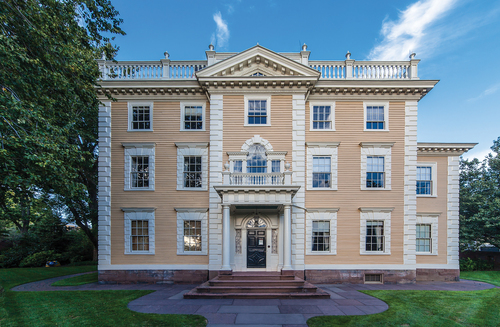
Figure 9. Detail, Les Vues d’Amérique du Nord, created by Jean-Julien Deltil in 1834 and printed by by Zuber & Cie in France. “Installation photograph at the Nightingale-Brown House, Brown University,” Karen Philippi (karenphilippi.com).

If the field of preservation is to meaningfully change, equity would need to become central to policies and procedures at federal and state levels. That would mean that the Section 106 review process would invite community members who use a historic structure to provide testimony or voice concerns about impact, and these testimonials would have weight, which would require an update to the National Historic Preservation Act of 1966. It would mean that federal lists like the National Register of Historic Places or National Historic Landmarks would be required to complete annual equity audits to provide transparency and accountability, and that such audits would also be required of state historic preservation commissions in regard to state registers and surveys. It would mean that university curricula would require coursework that interrogates the history and systemic racial bias of the field (rather than listing them as electives, if they are even taught at all), and curate programs that center questions of ethics, justice, and power.
These kinds of changes are beginning to happen in a field adjacent to preservation: public art. The Chicago Board of Education in 2020 established a new set of policies that regulate its public art collection, installed at schools and in administrative buildings across the city. The new policies require an annual equity audit of the art collection. They also make it easier to remove artwork and take community viewpoints into account when making these decisions via the creation of an empowered “diverse and representative steering committee.”Footnote15
Like legal and educational theory and practice, preservation is a system that regulates rights and privileges. In this system, land ownership is key, because it confers the power to determine whose stories are memorialized and whose are erased. And yet, preservation seems to have escaped sustained critical scrutiny; as hegemonic spatial practices go, it has had a long run at quietly constructing a public landscape that legitimizes white power. The question now is whether reform and repair are possible.
David Harvey and others characterize the “right to the city” as a human right, drawing connections between geography, power, and justice. As Don Mitchell puts it, “Representation, whether of oneself or of a group, demands space.”Footnote16 Can preservation be used to expand and democratize rights to the city, rather than to constrain them?
Additional information
Notes on contributors
Marisa Angell Brown
Marisa Angell Brown is an associate director of the Center for Complexity at Rhode Island School of Design. A historian, educator, and curator, her research focuses on spatial and social practice, public art, and preservation. She has taught courses on these issues at Brown University and Rhode Island School of Design, and also teaches college credit-bearing courses at the women’s prison in Rhode Island. Her writing has appeared in Places Journal, Perspecta, Buildings and Landscapes, and the Journal of the Society of Architectural Historians, and her curatorial projects have been featured in Metropolis and Architectural Record. Brown has a PhD in the History of Art and Architecture from Yale University.
Notes
1 Over the last ten years, CRT has become a rallying point within alt-right communities, leading up to legislative actions or executive orders that banning the use of key CRT tenets in K–12 schools in Arkansas, Florida, Idaho, Iowa, Montana, New Hampshire, North Dakota, Oklahoma, Tennessee, Texas, Utah and Virginia, with legislation pending in about fifteen other states, including explicitly banning use of materials related to The 1619 Project in class. Media outlets like Fox News portray CRT as anti-American, warning that parental rights are being eroded by teachers who “view everything through the lens of critical race theory, and then transform education by applying those lessons through teaching children that America’s institutions, monuments, traditions, holidays, language, and foundational principles are systemically, irredeemably racist.” See Ian Prior, “The Definitive Proof Critical Race Theory Is Being Taught in our Schools,” Fox News, June 20, 2022, accessed November 1, 2022, https://www.foxnews.com/opinion/proof-critical-race-theory-taught-schools.
2 Gloria Ladson-Billings and William Tate, “Toward a Critical Race Theory in Education,” Teachers College Record (September 1995): 47–68. See also Gloria Ladson-Billings, “Just What is Critical Race Theory and What’s It Doing in a Nice Field Like Education?” International Journal of Qualitative Studies in Education 11:1 (1998): 7–24; and Adrienne Dixson and Celia Rousseau, “And We Are Still Not Saved: Critical Race Theory in Education Ten Years Later,” Race Ethnicity and Education 8:1 (March 2005): 7–27.
3 See Sasha Costanza-Chock, Design Justice: Community-Led Practices to Build the World We Need (Cambridge: MIT Press, 2020), the work of the Design Justice Network and the Design as Protest Black- and Indigenous-led collective.
4 Preservation’s reckoning is decades behind other fields, but counter-preservation theories and practices are emerging. See, for example, Erica Avrami, ed., Preservation and Social Inclusion (New York: Columbia University Press, 2020); the work of Natalia Escobar Castrillón, including Volume 4 of Oblique, titled “Anti-Racist Conservation Practices and Discourse” (Castrillón is the founder and editor-in-chief of Oblique, a journal of critical conservation studies/practice); the mission and work of the Association of Critical Heritage Studies, formed in 2012; and some of the #DismantlePreservation events organized by Sarah Marsom. Some of the strongest critiques of the field today come out of artistic practice, as artists are being commissioned to create counter-historical work in difficult sites, and others produce embodied, durational work that engages with preserved sites and stories. See the work of Ada Pinkston, Jazzmen Lee-Johnson, Haus of Glitter Performance Lab, Dread Scott and Yinka Shonibare, and No Longer Empty, created by Naomi Hersson-Ringskog.
5 Ladson-Billings and Tate, “Toward a Critical Race Theory,” 62.
6 June Manning Thomas and Marsha Ritzdorf, eds., Urban Planning and the African-American Community: In the Shadows (London: SAGE Publications, 1997), 6.
7 Richard Delgado, “Storytelling for Oppositionists and Others: A Plea for Narrative,” Michigan Law Review, 87 (Aug 1989): 2412.
8 See Delgado, “Storytelling”; Daniel Solórzano and Tara Yosso, “Critical Race Methodology: Counter-Storytelling as an Analytical Framework for Education Research,” Qualitative Inquiry 8:1 (2002): 23–44; and Dixson and Rousseau, “And We Are Still Not Saved.”
9 Delgado, “Storytelling,” 2438.
10 The EPA has a comparatively sizable number of Native staff people due to its ongoing work with tribal communities; in 1992, the agency established the Environmental Justice program, which serves Native and Indigenous communities.
11 Lori Windle, Chairwoman for the Board of Directors of SAIGE, letter to Stephen A. Perry, administrator, General Services Administration, January 9, 2004.
12 Opposition to Depictions Offensive to American Indians in Federal Buildings, The National Congress of American Indians Resolution, October 10–15, 2004, #FTL-04-057.
13 Cinda Hughes, interview with the author on Zoom, August 4, 2021.
14 Hughes.
15 Chicago Public Schools, Acquisition, Ownership, Conservation and Maintenance of the Chicago Public Schools’ Works of Art, adopted February 26, 2020, 4. https://www.cps.edu/sites/cps-policy-rules/policies/800/802/802-2/, accessed January 2, 2023.
16 Don Mitchell, The Right to the City: Social Justice and the Fight for Public Space (New York: The Guilford Press, 2003), 33.

